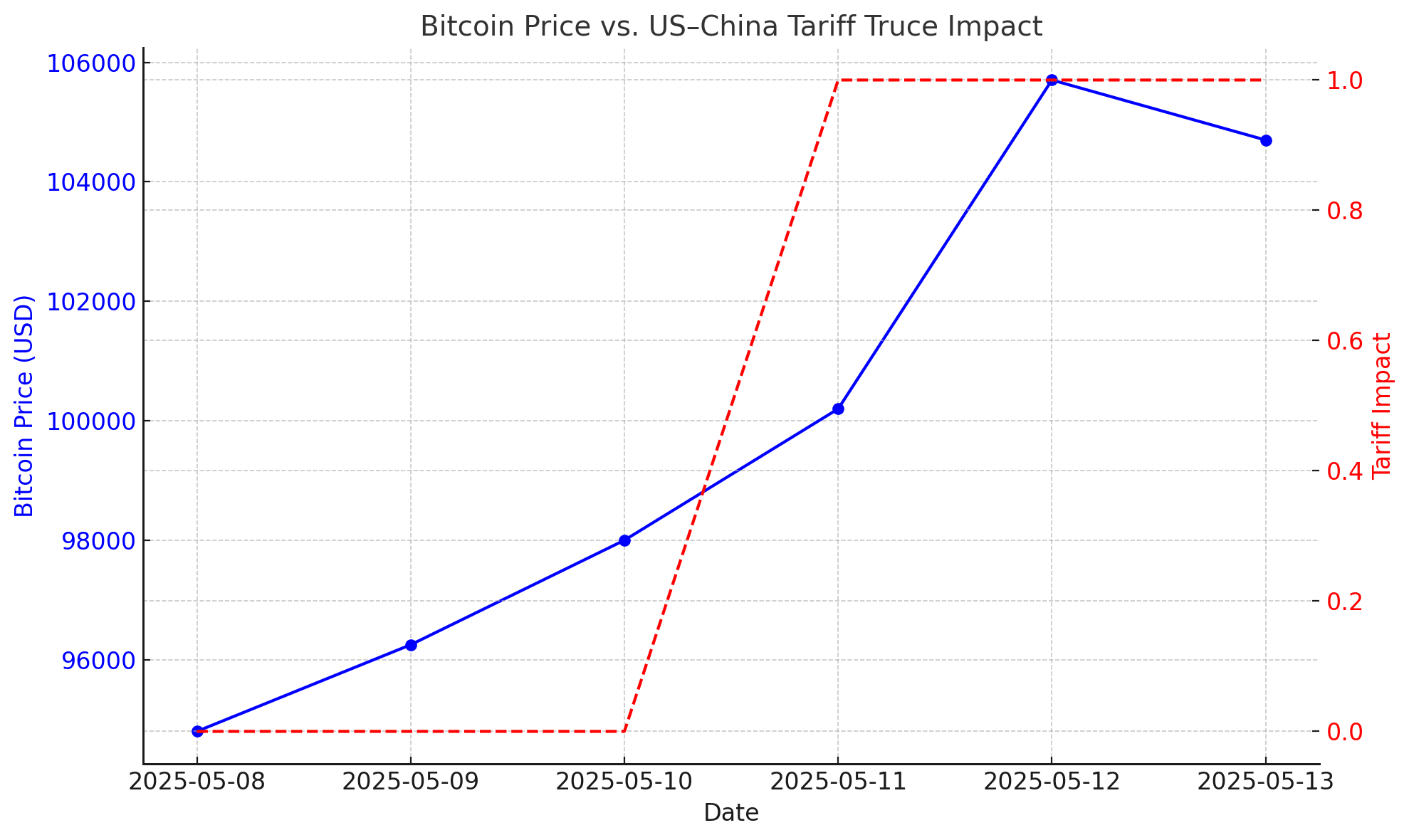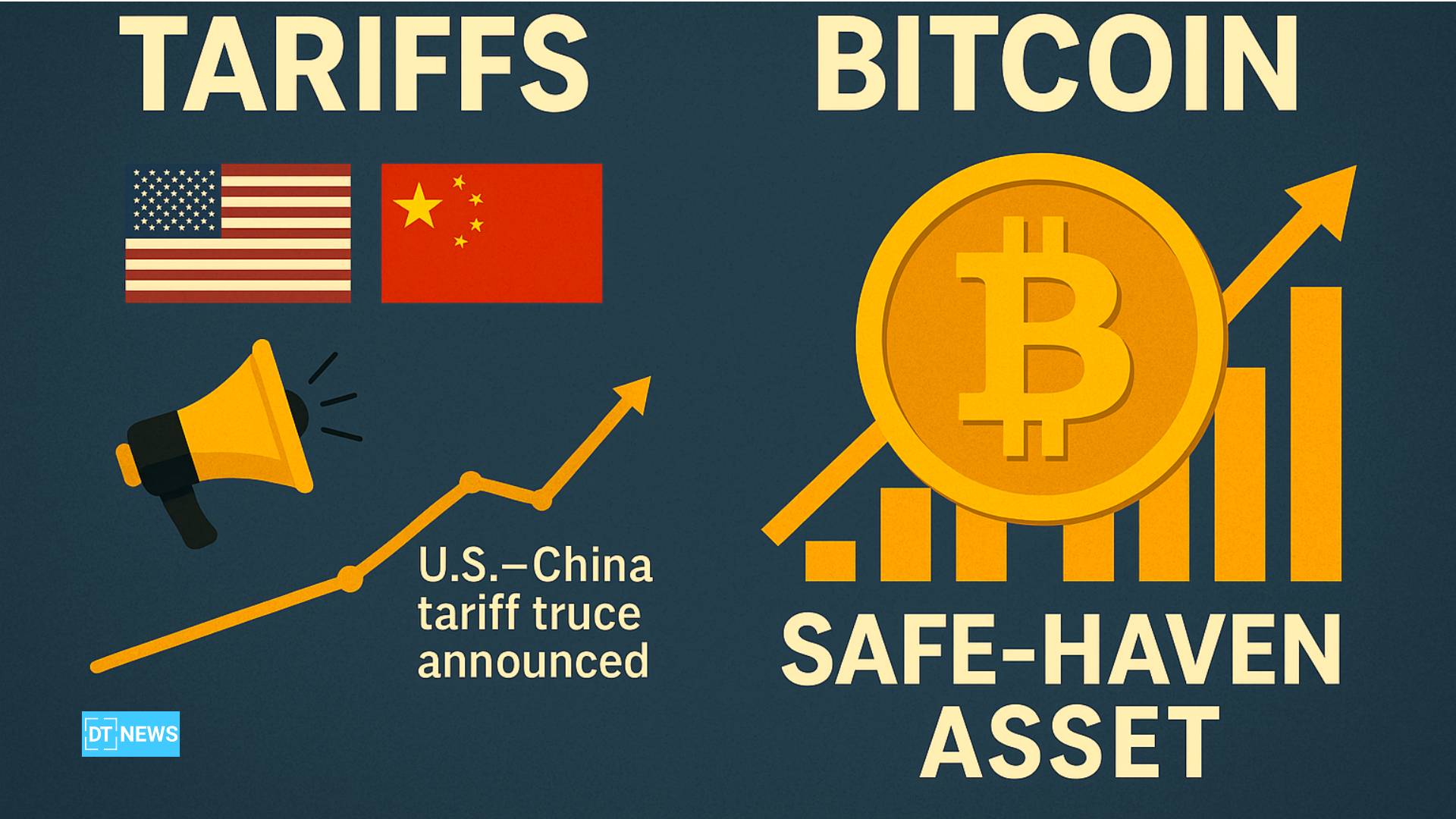Bitcoin’s long-debated reputation as a “safe-haven asset” was thrust into the spotlight this week following the announcement of a 90-day tariff suspension between the United States and China. While the move momentarily ignited a sharp rally in the crypto markets, pushing Bitcoin to $105,705, just shy of its all-time high, the subsequent volatility has raised new questions about BTC’s role as a hedge during macroeconomic uncertainty.
- Tariff Truce Triggers Bitcoin Surge to $105,700
- The Retreat: From Rally to Reassessment
- Is Bitcoin Really a Safe-Haven Asset?
- The Tariff Effect: Risk-On vs Risk-Off Behavior
- Bitcoin Price Metrics
- Long-Term Implications for Bitcoin
- Conclusion: A Crucial Moment for BTC’s Identity
- Frequently Asked Questions (FAQs)
- 1. Why did BTC spike after the U.S.–China tariff truce?
- 2. Is BTC still considered a safe-haven asset?
- 3. What does the tariff truce mean for BTC in the long term?
- Glossary of Key Terms
As markets recalibrate amid easing geopolitical tensions, Bitcoin is now being tested against the very narrative that once propelled its institutional adoption: resilience in chaos.
Tariff Truce Triggers Bitcoin Surge to $105,700
On May 12, 2025, Beijing confirmed a temporary halt on tariffs affecting over $200 billion worth of goods imported from the U.S., a move met with reciprocal action from Washington. The immediate aftermath sent ripples across global markets, with equities rallying and crypto responding in tandem.
Bitcoin — often viewed as a hedge against inflation and geopolitical instability, spiked over 12% within hours, breaking through a key resistance at $95,000 and soaring to $105,705, its highest level since January.
“This rally reaffirmed Bitcoin’s reflexive sensitivity to macro headlines. It reacts like a risk asset, but the long-term value proposition is very much in play,” said Marcus Zhang, senior analyst at Bitwave Capital.
Ethereum followed suit, rising above the $3,000 mark for the first time in weeks, while Solana, XRP, and other top altcoins posted mid-to-high single-digit gains.

The Retreat: From Rally to Reassessment
However, what began as a bullish surge quickly turned into a measured pullback, as Bitcoin dropped to around $104,700, reflecting market caution. The initial rally had priced in optimism, but as traders digested the details of the truce, a temporary measure with no long-term resolution, the sustainability of BTC’s breakout came under scrutiny.
“It was a knee-jerk reaction,” noted crypto macro strategist Leah Wald. “Bitcoin surged because the news was net positive for risk assets. But as soon as capital rotated back into traditional equities, crypto lost its momentum.”
Is Bitcoin Really a Safe-Haven Asset?
The broader conversation now centers on Bitcoin’s true classification. Is it digital gold? A speculative risk asset? Or both?
Historically, safe-haven assets, like gold and U.S. Treasury bonds, are expected to rise during times of economic uncertainty and drop when optimism returns. BTC’s behavior has increasingly mirrored tech stocks and other risk-on assets, casting doubt on its safe-haven credentials.
Yet some experts argue that BTC is evolving, not failing.
“Safe-haven status is a long game,” said Edward Moya, senior market strategist at OANDA. “We can’t judge Bitcoin’s behavior based on a few days of volatility. Its supply mechanics, decentralization, and censorship resistance still make it a strategic hedge.”
The Tariff Effect: Risk-On vs Risk-Off Behavior
The U.S.–China tariff suspension momentarily improved the global risk climate. Institutional investors responded by rotating funds back into equities and bonds, leading to pullbacks in Bitcoin, gold, and oil, all of which had been elevated by weeks of economic pessimism.
According to data from IDN Financials, BTC and gold both fell by over 3% in the 48 hours following the truce. The parallel movement further supports the view that BTC and gold share a macro narrative, even if their short-term behavior diverges.
Bitcoin Price Metrics
| Metric | Value |
|---|---|
| Current Price | $104,720 |
| 24h Change | +9.3% |
| All-Time High | $109,356 |
| Market Cap | $2.06 Trillion |
| 24h Trading Volume | $88.1 Billion |
| YTD Performance | +88.2% |
| Dominance | 52.4% |
Long-Term Implications for Bitcoin
Despite the volatility, Bitcoin’s price has still posted impressive year-to-date gains of over 88%. The macro outlook, including a potential Fed pivot, global liquidity concerns, and rising sovereign debt, supports a bullish thesis for BTC.
The question now is not whether BTC is volatile, but how it behaves during different types of macro shocks. In times of inflationary pressure and currency devaluation (as seen in Argentina and Nigeria), BTC has acted as a value-preserving asset. During periods of market optimism, it often behaves like a high-beta tech stock.
“Bitcoin’s dual nature is both its strength and its weakness,” said crypto researcher Aysha Karim. “It offers a hedge in crisis but also rallies during tech booms. That versatility is what makes it unique.”
Conclusion: A Crucial Moment for BTC’s Identity
The U.S.–China tariff pause may have temporarily shifted capital flows back into traditional markets, but Bitcoin’s behavior during this period underscores its growing importance in global finance. It is no longer merely a hedge or a tech play — it is an asset class reacting dynamically to macro catalysts.
As more institutions and sovereign entities weigh digital assets in their portfolios, BTC’s response to events like tariff changes, interest rate policy, or geopolitical flare-ups will shape its future utility.
Whether Bitcoin becomes the digital gold of this century or remains a high-growth speculative vehicle depends not just on its tech, but on how it weathers the world’s storms — and today, it faces one of its most defining tests yet.
Frequently Asked Questions (FAQs)
1. Why did BTC spike after the U.S.–China tariff truce?
BTC surged past $105,000 after the tariff truce was announced because easing geopolitical tensions boosted investor confidence and encouraged risk-on behavior across global markets.
2. Is BTC still considered a safe-haven asset?
BTC’s pullback after the initial surge raised doubts. While it is often seen as digital gold, recent movements show that BTC behaves more like a risk asset during short-term macro events.
3. What does the tariff truce mean for BTC in the long term?
The tariff truce highlights how sensitive BTC is to macroeconomic headlines. Over time, its decentralized and limited-supply design may support its safe-haven narrative, but short-term volatility remains.
Glossary of Key Terms
BTC: Abbreviation for Bitcoin, the world’s largest and most traded cryptocurrency.
Safe-Haven Asset: An investment expected to retain or increase in value during market turmoil (e.g., gold, U.S. bonds).
Tariff Truce: A mutual agreement between countries to suspend or reduce trade tariffs temporarily.
Risk-On Asset: Financial assets that perform well when investors are optimistic and more willing to take risk (e.g., tech stocks, crypto).
Geopolitical Tensions: Conflicts or negotiations between countries that influence economic markets, like the U.S.–China trade war.
Market Pullback: A temporary reversal in the price direction of an asset after a strong rally.
Sources and References
CoinMarketCap BTC Price Page – Live BTC price, volume, and performance metrics




















































































































